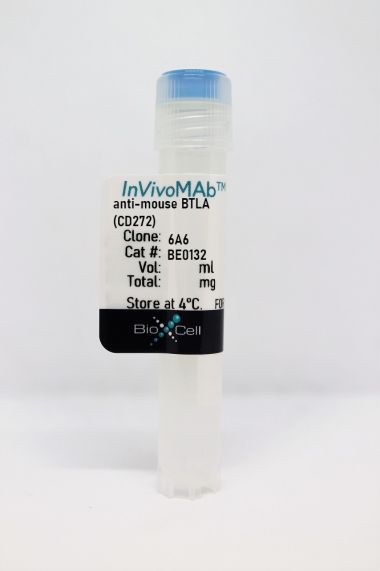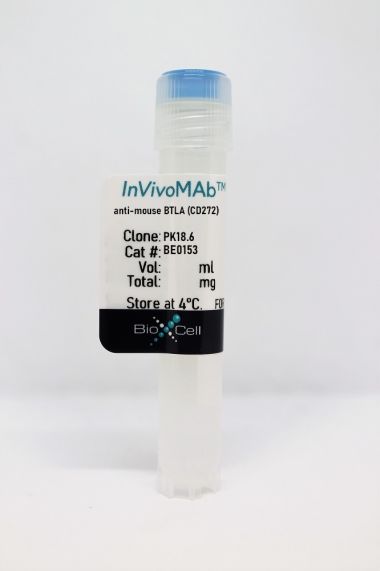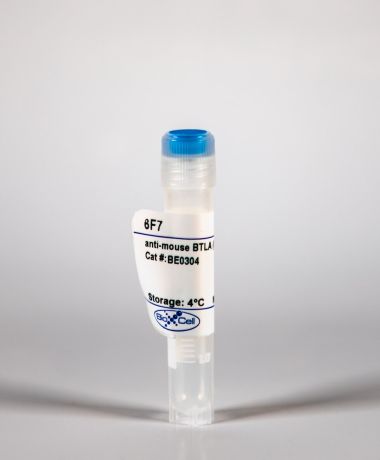InVivoMAb anti-mouse BTLA (CD272)
Product Details
The HMBT-6B2 monoclonal antibody reacts with mouse B- and T-lymphocyte attenuator (BTLA) also known as CD272. BTLA is an Ig superfamily member which is expressed on B cells, T cells, macrophages, dendritic cells, NK cells, and NKT cells. Like PD-1 and CTLA-4, BTLA interacts with a B7 homolog, B7-H4. However, unlike PD-1 and CTLA-4, BTLA displays T cell inhibition via interaction with tumor necrosis family receptors, not just the B7 family of cell surface receptors. BTLA is a ligand for herpes virus entry mediator (HVEM). BTLA-HVEM complexes have been shown to negatively regulate T cell immune responses.Specifications
| Isotype | Armenian hamster IgG |
|---|---|
| Recommended Isotype Control(s) | InVivoMAb polyclonal Armenian hamster IgG |
| Recommended Dilution Buffer | InVivoPure pH 7.0 Dilution Buffer |
| Conjugation | This product is unconjugated. Conjugation is available via our Antibody Conjugation Services. |
| Immunogen | Mouse BTLA-Fc fusion protein |
| Reported Applications |
in vivo BTLA blockade Flow cytometry |
| Formulation |
PBS, pH 7.0 Contains no stabilizers or preservatives |
| Endotoxin |
<2EU/mg (<0.002EU/μg) Determined by LAL gel clotting assay |
| Purity |
>95% Determined by SDS-PAGE |
| Sterility | 0.2 μM filtered |
| Production | Purified from cell culture supernatant in an animal-free facility |
| Purification | Protein G |
| RRID | AB_2894782 |
| Molecular Weight | 150 kDa |
| Storage | The antibody solution should be stored at the stock concentration at 4°C. Do not freeze. |
Recommended Products
Flow Cytometry
Mathew, R., et al. (2014). "A negative feedback loop mediated by the Bcl6-cullin 3 complex limits Tfh cell differentiation" J Exp Med 211(6): 1137-1151. PubMed
Induction of Bcl6 (B cell lymphoma 6) is essential for T follicular helper (Tfh) cell differentiation of antigen-stimulated CD4(+) T cells. Intriguingly, we found that Bcl6 was also highly and transiently expressed during the CD4(+)CD8(+) (double positive [DP]) stage of T cell development, in association with the E3 ligase cullin 3 (Cul3), a novel binding partner of Bcl6 which ubiquitinates histone proteins. DP stage-specific deletion of the E3 ligase Cul3, or of Bcl6, induced the derepression of the Bcl6 target genes Batf (basic leucine zipper transcription factor, ATF-like) and Bcl6, in part through epigenetic modifications of CD4(+) single-positive thymocytes. Although they maintained an apparently normal phenotype after emigration, they expressed increased amounts of Batf and Bcl6 at basal state and produced explosive and prolonged Tfh responses upon subsequent antigen encounter. Ablation of Cul3 in mature CD4(+) splenocytes also resulted in dramatically exaggerated Tfh responses. Thus, although previous studies have emphasized the essential role of Bcl6 in inducing Tfh responses, our findings reveal that Bcl6-Cul3 complexes also provide essential negative feedback regulation during both thymocyte development and T cell activation to restrain excessive Tfh responses.
in vivo BTLA blockade
Ishida, W., et al. (2012). "B and T lymphocyte attenuator regulates the development of antigen-induced experimental conjunctivitis" Graefes Arch Clin Exp Ophthalmol 250(2): 289-295. PubMed
PURPOSE: To investigate the roles that B and T lymphocyte attenuator (BTLA) and herpesvirus entry mediator (HVEM) play in the development of antigen-induced experimental conjunctivitis (EC). METHODS: BALB/c mice were immunized with ragweed (RW) in alum. Ten days later, the mice were challenged with RW in eye drops. After 24 hours, the conjunctivas, blood and spleens were collected for histological analysis, measurement of serum immunoglobulin (Ig) levels, and both flow cytometric analysis and cytokine assays, respectively. The mice were injected intraperitoneally with anti-BTLA antibody, anti-HVEM antibody or control antibody during either induction phase or effector phase. RESULTS: Induction-phase treatment with anti-BTLA antibody but not anti-HVEM antibody significantly increased conjunctival eosinophil infiltration. Treatment with either antibody during the effector phase did not affect conjunctival eosinophil infiltration. Anti-BTLA antibody treatment during the induction phase reduced the B cell compartment and increased the CD11b-positive cell compartment in splenocytes. Additionally, anti-BTLA treatment upregulated IL-4 and IL-10 production of splenocytes stimulated by RW. CONCLUSIONS: BTLA regulated the development of EC possibly by downregulating Th2 cytokine production and adjusting the compartments of immunocompetent cells. The regulation of EC by BTLA may be mediated by BTLA ligands other than HVEM.








